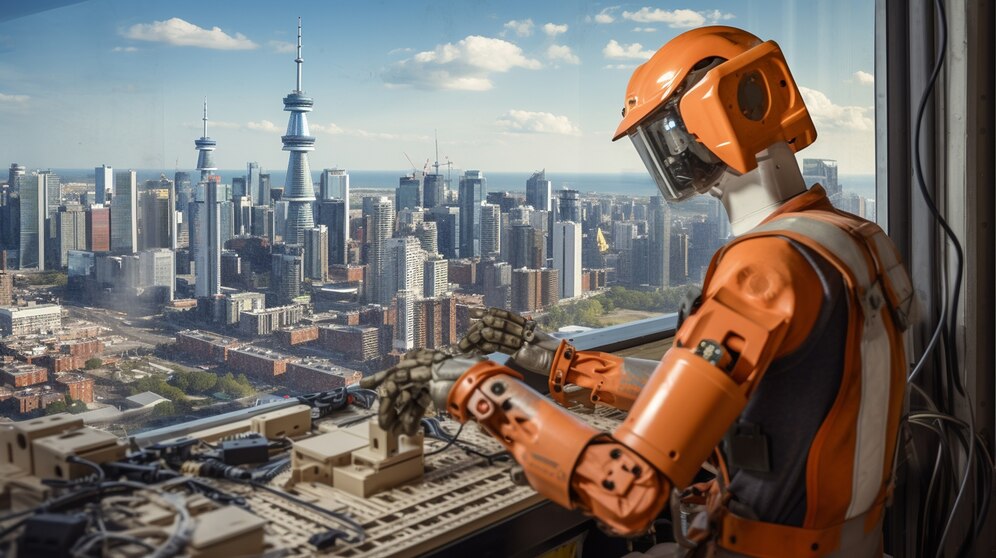Over the past few years, the construction sector has seen remarkable changes thanks to the adoption of advanced technologies. One standout innovation is Artificial Intelligence (AI), which holds immense promise for transforming different construction phases.
Mainly, Generative AI has emerged as a critical player, empowering architects, engineers, and construction experts to enhance efficiency, refine designs, and spark new waves of creativity. This piece delves into how Generative AI is reshaping construction and unlocking its full potential.
AI in Construction
Artificial Intelligence has become a cornerstone in the construction industry, offering various technologies and applications to enhance efficiency, productivity, safety, and sustainability across every project’s life cycle stage. From initial planning and design to construction and ongoing maintenance, AI-driven solutions are revolutionizing traditional practices and promoting forward-looking strategies.
One such advancement is Generative AI services, a subset of AI technology that takes innovation to new heights. By utilizing algorithms to generate design alternatives within predefined parameters and constraints autonomously, Generative AI pushes the boundaries of creativity and problem-solving.
Through the fusion of machine learning and computational creativity, construction experts can explore diverse design possibilities, optimize intricate structures, and devise groundbreaking solutions to complex challenges.
Key Advantages of Generative AI in Construction
● Resource Optimization
Optimizing resource allocation and utilization is crucial to minimize waste and boost productivity in construction attempts. Generative AI algorithms play a pivotal role by sifting through extensive datasets encompassing material characteristics, environmental variables, and project specifications.
This analysis enables the algorithms to suggest optimal materials, construction techniques, and structural arrangements. By doing so, Generative AI services not only trim construction expenses but also lessen environmental footprint and transform project sustainability.
● Rapid Prototyping
Conventionally, crafting prototypes and mock-ups for construction ventures proves arduous and expensive. Generative AI services company can revolutionize this practice by swiftly crafting virtual prototypes according to defined criteria.
Through simulating diverse scenarios and scrutinizing performance indicators, construction teams can assess design viability, pinpoint probable challenges, and make educated choices before embarking on physical construction. This approach conserves time and resources and curtails the likelihood of errors and reiterations.
● Design Optimization
Generative AI empowers architects and engineers to swiftly and effectively explore many design possibilities. Generative AI applications can produce design variations by feeding project parameters, goals, and limitations into the algorithm.
This capability enables professionals to pinpoint the most advantageous solutions regarding cost-effectiveness, performance, and environmental impact. Through iterative refinement, teams can continuously enhance designs, resulting in superior outcomes and heightened project efficiency.
● Adaptive Scheduling & Planning
Construction frequently encounters uncertainties and unexpected hurdles, throwing schedules and budgets off course. Generative AI introduces a dynamic dimension to planning and scheduling by persistently scrutinizing real-time data, including weather updates, supply chain statuses, and workforce availability.
By dynamically adjusting schedules and resource allocations in light of evolving circumstances, Generative AI aids construction teams in mitigating risks, curbing delays, and guaranteeing punctual project fulfilment.
● Improved Communication & Collaboration
Efficient collaboration among project stakeholders is pivotal for achieving successful project outcomes. Generative AI platforms foster collaboration by furnishing a centralized hub for instantly exchanging design concepts, feedback, and revisions.
By facilitating smooth communication and coordination among architects, engineers, contractors, and clients, Generative AI cultivates a collaborative milieu that nurtures innovation and ingenuity.
Difficulties and Future Outlook
While Generative AI in construction holds tremendous potential for revolutionizing the construction sector, several hurdles must be addressed to unlock its full capabilities. These challenges encompass data privacy and security concerns, seamless integration with existing workflows and systems, bridging skill gaps among construction professionals, and ensuring compliance with regulatory standards. Surmounting these obstacles will necessitate collaborative efforts among industry stakeholders, investments in training and education, and the establishment of robust frameworks and guidelines for AI integration in construction practices.
The outlook for Generative AI in construction appears promising, buoyed by ongoing advancements in AI algorithms, computational prowess, and data analytics capabilities. As the technology matures and becomes more accessible, we anticipate widespread adoption of Generative AI throughout the construction realm. This transition is poised to usher in heightened efficiency, sustainability, and innovation in the built environment.
Conclusion
Generative AI signifies a profound shift in the conception, design, and execution of construction projects. Leveraging the capabilities of machine learning and computational creativity, Generative AI empowers construction experts to refine designs, simplify processes, and foster innovation throughout the project journey. Despite existing challenges, the transformative impact of Generative AI on construction is undeniable, heralding a future where buildings are not just structures but intelligent, sustainable, and attuned to societal needs.
